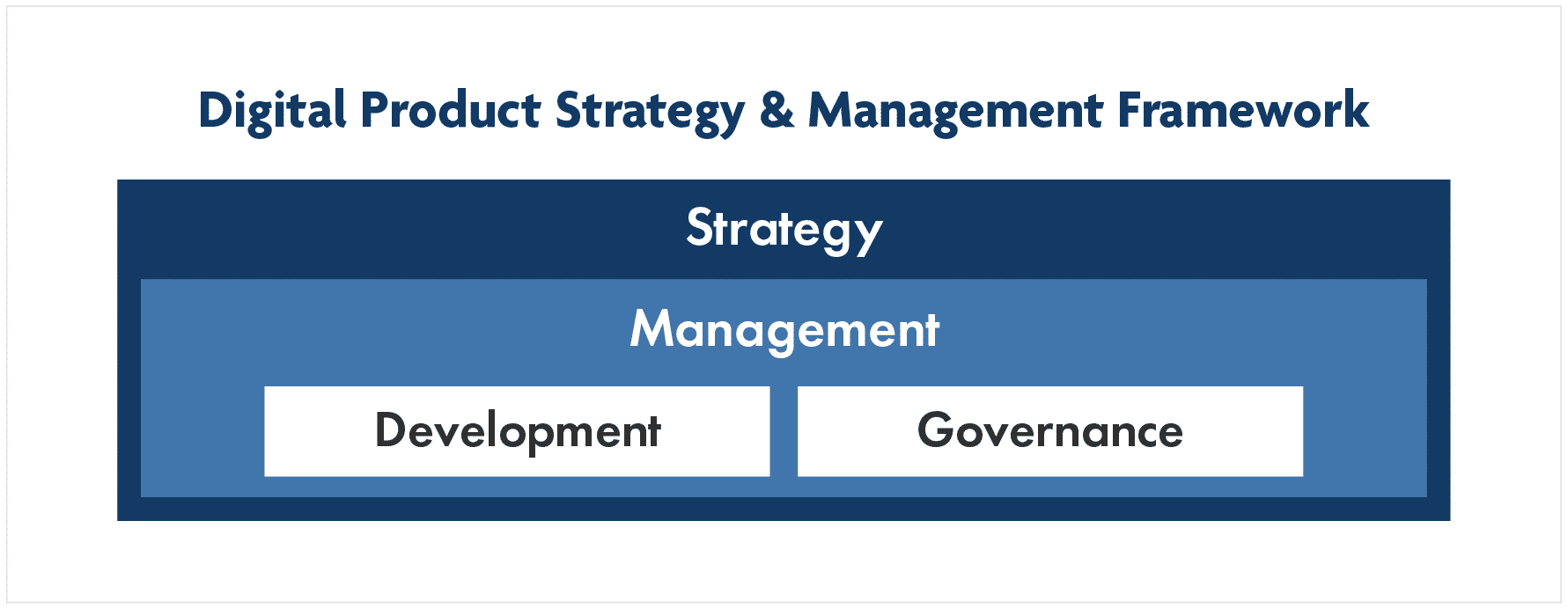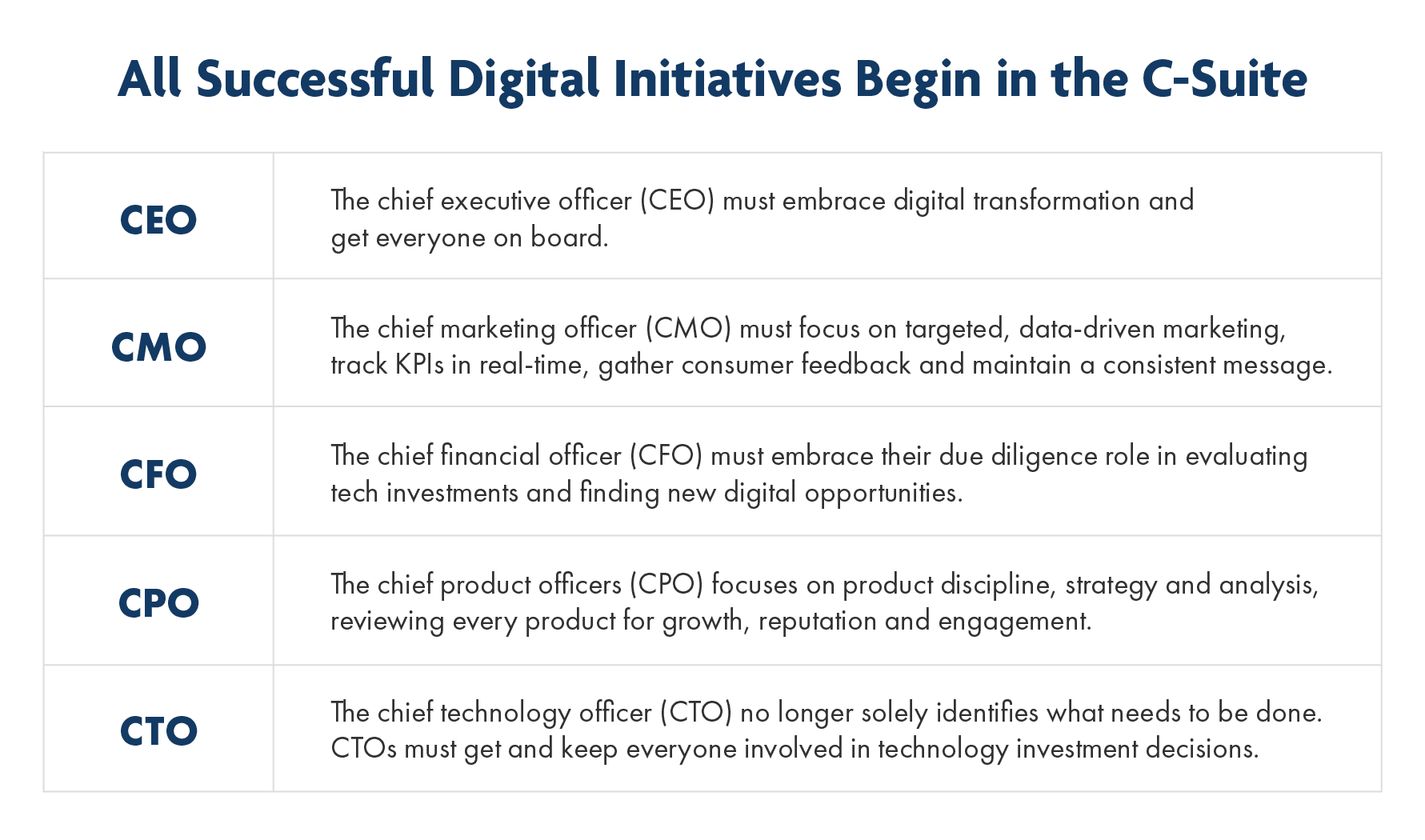Inside this Guide
- Introduction
- Digital product strategy and management: A glossary
- How to get started with a digital product strategy
- Components of successful digital product management
- Digital product development – the lean, agile way
- Understanding digital product governance
- Avoiding disaster: 4 common product pitfalls
- Final thoughts
Digital Product Strategy and Management
Introduction
Whether your actual product is a virtual or physical good or service, almost every business these days needs to employ digital means to attract, sell to, serve and support their customer base.
It’s not just about creating a new website or launching a new email platform. Elevating your company’s digital game can involve any and every aspect of your business.
This may involve initiatives, such as:
- Improving the customer purchasing or support experience.
- Finding new ways to manage inventory or logistics.
- Discovering how to automate key processes.
In many cases, digital initiatives spring from a desire to know more about your customers at every stage of your sales funnel.
Some companies bring forth new capabilities gradually, with specific efforts to improve current products or offer new services. Others dive in head-first, embracing new missions and investments that put digital components, service delivery and data at the heart of everything – a more holistic process known as digital transformation.
Whether evolutionary or revolutionary, digital initiatives cannot be pieced together in hopes of keeping up with the competition. They must be part of a broader strategy that begins in the C-suite and becomes integrated throughout the company.
Effective digital product strategy is the common denominator in the success of any modern company. In order to drive successful new initiatives, it’s important to understand the framework of digital product strategy and management as shown below.

Digital product strategy and management: A glossary of terms
In this guide, we give corporate executives a quick way to understand the concepts behind creating and growing revenue from digital products. But first, let’s clear up some definitions, including what happens when the word “digital” is added to these common business terms:
Product strategy
Having a digital product strategy means your organization has defined the value you want to deliver to your customers through software and digital tools. It’s a plan that tells staff and customers where you are applying your focus. It also includes a strategic plan, or product roadmap, for how to get there.
Having a product strategy isn’t the same as having a strategic vision: It must be specific, actionable and constantly evolving to fit changing market and technology landscapes.
Product management
Gartner helpfully defines digital product management as “the process of conceiving, defining, delivering, monitoring and refining products in, and withdrawing products from, a market in order to maximize business results.”
Note that this definition presumes there already exists a strategy for such a process. Within the broader category of digital product management are two sub-categories: development and governance.
Product development
This is the earliest phase of digital product management and the process by which your organization defines, designs, develops and deploys new offerings or enhancements to existing ones. In doing so, it is essential to orient everything around your best understanding of the needs of the end user (or consumer) of your products, an approach variously known as design thinking or user-centered design.
There’s more to come on that as we continue through this guide, as well as our take
on why digital product development is best pursued using agile and lean methodologies.
Product governance
A key aspect of digital product management, digital governance, according to one of the topic’s gurus, Lisa Welchman, is “a discipline that focuses on establishing clear accountability for digital strategy, policy and standards.” We agree with Welchman’s view that, while governance should be owned by a senior executive, it is also a collaborative exercise, involving input and co-ownership from across the executive suite.

How to get started with a digital product strategy
In any organization, strategy sits just below Mission, Vision and Values – those statements that define the reasons why your enterprise exists, what you want to achieve and what you care about.
Having a digital product strategy used to be considered just one of many ways to carry out an organization’s broader product strategy. More and more, however, they are indistinguishable.
In the past, other than your chief technology officer or chief data officer, corporate heads did not need to be digital-savvy. The C-suite focused on the big-picture things. Digital initiatives were important, but not defining.
That perception no longer applies. Digital isn’t everything, but it is the key to staying competitive and launching additional revenue streams in many, if not most industries. That means every seat around the table, not just the CEO, has a role to play.

The best way to communicate a digital product strategy is with a graphical illustration known as a “product roadmap” that shows each product, where it is in its lifecycle and what the goals are for the product in the coming quarter and year.
Often, creating an outline for such an illustration is the best way to begin the decision-making and prioritization processes needed to reach decisions on the path forward for existing and new digital products or initiatives.
But how exactly do you (and should you) prioritize your roadmap?
One prioritizing element we try to include is whether a product will continue to Run, Grow or Transform.
- “Run” means to operate without further investment – it’s also known as a “harvest” strategy, to maximize remaining revenue potential while allowing the product to eventually expire.
- “Grow” indicates the product continues to have the potential to increase revenue if further investment is made.
- “Transform” means the product can only grow if it is completely overhauled in the market. Using this approach, it’s easier to see why “digital transformation” is a big deal: Everything the organization does must be rethought or rebuilt to capture future market growth.

Of course, it’s impossible to know whether to Run, Grow or Transform a product if you’re uncertain about what the market is saying.
Sales trends are only one data point. You need to have a firm grounding in what your users need from you and have a reliable customer feedback loop. In user-centered design, this means doing some solid primary customer research, including having conversations with individuals or small groups of people who inherently need what you have to offer. User needs analysis and customer feedback loops aren’t optional – they must be included for your product development efforts to pay off.
Successful enterprises balance business needs and mission with what users are saying they need to accomplish things in their daily or work lives.
What are the components of successful digital product management?
Successful product management is more than a roadmap. You also need to consider:
- Who will do the work of moving things along the product roadmap?
- Who is best suited to create those important links between the C-level decision-makers, the managers and the designers and developers?
- Who best understands how to empower designers and developers to stay on point and do their best work, while staying within budget and meeting user needs as well as C-suite goals?
Thankfully, all of this can be found in the job description of a digital product manager.
Key insight: Great products are led by great product managers
All product managers, of course, must be excellent planners, able to visualize individual components and the entire process so they can assign goals for their team members.
They also need to master the ability to prioritize within limited budgets and spend time researching their company’s products and analyzing data so they know what works and what doesn’t. They must constantly gather the information that can improve both products and production.
The role of digital product manager requires the rapid development of new and often complex products to stay competitive.
Because software improves constantly, companies need to make frequent updates to existing products as they create new ones. Minor updates, for example, can be prioritized to get improvements out to consumers in a shorter timeframe. This requires balancing short-term operational needs with longer-term enhancements and initiatives.
Staying current is difficult. Being forward-thinking is more so.
A digital product manager must put themselves into the user’s shoes to make certain each product is easy to use and delivers what they need. Maintaining an intuitive, even delightful, experience takes a lot of work, to avoid frustrated consumers bailing on the product and look for something better.
Product managers are not the same as project managers – but they work closely together. Digital initiatives need project managers, while product managers usually represent the business stakeholders in a project.
Organizations with multiple, cross-functional digital initiatives should establish a Project Management Office (PMO) capability. This will help ensure tasks are staying on track, technology decisions are not being made in silos and resources are being effectively managed.
Digital product development – the lean, agile way
The nature of digital-based products requires a fresh approach to building and enhancing a product line. In the past, many companies stuck to the assembly line, or “waterfall,” method of production, where each step – definition, design, development and deployment – happens in total and in sequence.
Detailed upfront documentation, a strict management hierarchy and a rigid development process were features of this approach. While this method worked for producing cars, furniture and consumer goods, it did not translate well to software development. Developing digital products, services and experiences requires an alternative method.

Today, many digital product managers have embraced agile development and lean process methodologies, which emphasize small teams who collaborate on design, development and deployment in a series of iterations.
Using agile and lean process methodologies, value is delivered incrementally, and occasional failures are not only tolerated but celebrated as an important part of the iteration process.
This framework works better because it doesn’t force the development team to follow a process that quashes flexibility and ongoing improvement. It works faster and better by allowing the team members to play to their strengths.
Understanding (and planning for) digital product governance
Each role in the C-suite must also understand one of most important digital product management responsibilities: product governance.
Traditional product governance focuses on compliance issues and risk reduction. This approach is not enough for digital product management, especially since corporate-wide knowledge of digital products may be low. Many corporate executives would have difficulty naming all their digital initiatives.
In the rush to stay current with competitors, the emphasis has been on producing and distributing products quickly without a well-developed plan and minimal control built into the framework.
The C-suite has a pivotal role in digital product governance that covers the lifecycle of the product. Someone at the top table – sometimes it’s the CTO or COO, sometimes it’s a stand-alone position – should serve as chief risk officer, in charge of financial, non- financial and operational risk assessments of each product. And the company attorney or retained counsel should act as chief regulatory/legal officer, overseeing the regulatory and legal obligations pertaining to these products, including environmental, state and federal and social mandates.
Product governance in the digital realm requires that you go beyond what you’ve done for physical products. To regain control, you should consider implementing the following steps:
- Create a comprehensive inventory of digital initiatives. This information needs to be centralized for easy access by the C-suite and higher management.
- Work to decentralize digital initiatives. Initially, a chief digital officer (CDO) may be necessary as the company works to accomplish digital transformation. Eventually, these efforts should move to individual business units. When that happens, it means your company has fully integrated its digital efforts.
- Centralize your evaluation of digital products. You still need a central group to analyze and green light digital products to promote product innovation and implement initiatives and necessary updates.
- Align KPIs with the results you want for each initiative. You need to do away with fuzzy standards and complex language to establish clear, attainable KPIs to create valuable and profitable digital products.
- Eliminate “siloed solutions.” You can achieve this goal by adopting technical consistency across the board and regularly integrating new initiatives with current systems.
You should also develop a comprehensive mapping system to improve C-suite knowledge and control of digital initiatives.
Digital product management structure differs from traditional efforts, so mapping the elements makes sense. Of course, you should continue monitoring governmental compliance and evaluating digital product risk factors. This area is legally complex, particularly because of the parallel development of similar technology.
Avoiding disaster: 4 common product pitfalls
Problems are part of any job, but digital product strategy and management has its own set of sand traps and landmines. Senior executives and digital product managers alike should be aware of some of the most common, including:
Pitfall #1: Putting technology first
Tech nerds love to include the latest bells and whistles in the tech world. But sometimes, adding these extras hurts the product. It may make the item too costly, too complicated or just unwieldy. The focus must be on the customer’s wants and needs. Remember, you are not building the product for yourselves.
Pitfall #2: Hanging on to an idea
Brilliant ideas are rare, and unique ideas are more so. You can quickly become too attached to your idea to realize that it needs modification or a complete overhaul. Or, it may even need to be tossed into the bin. Again, the idea means nothing if it does not lead to a product consumers want.
Pitfall #3: Refusing to adapt
Industry changes at lightning speed. This means your project could show promise one day, but the next day, others may have surpassed it. A digital initiative rarely develops as you originally planned. Failure to adapt to new information in the middle or end of a project is a killer in the digital world.
Pitfall #4: Following traditional budgeting
For all the reasons listed above, traditional budget estimates do not work for digital project management. Because things change constantly, any forecast for the entire project is worthless. A better approach is to budget money for each step of the process. Perhaps you will choose categories such as design, development part one, part two, part three and testing. No matter what divisions you choose, remember to chunk the budget.
You make your life harder anytime you try to apply traditional constructs to digital applications, and you will be less successful as well.
Final thoughts
Digital product strategy and management is about more than just building great products. In fact, studies show that product and executive teams that focus on digital initiatives produce higher revenue and increased growth. No company department is an island.
To be successful, the C-suite must listen to customers to create a comprehensive product strategy, one that connects the goals of the department to the organization’s overarching goals. Making that connection ensures understanding of product cost, delivers excellent product positioning and inspires customers to embrace your products.




